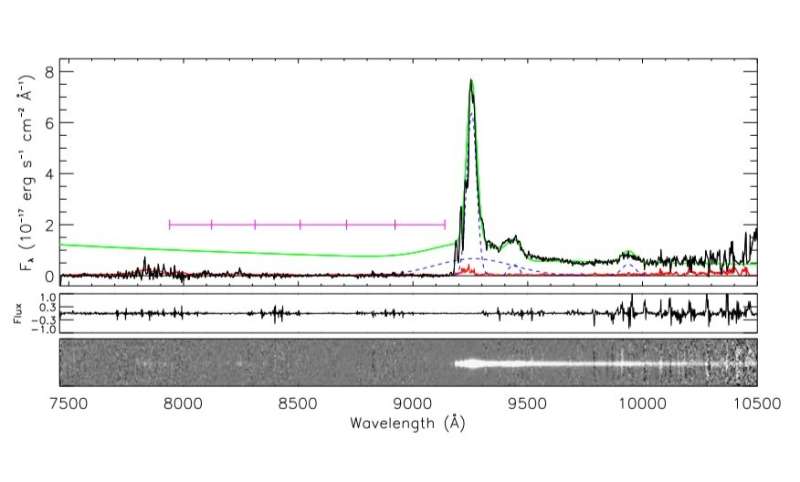March 30, 2020 report
Astronomers observe high-redshift quasar PSO J006.1240+39.2219 with Subaru telescope

Using the Subaru telescope, astronomers from Taiwan have conducted spectroscopic observations of a high-redshift quasar designated PSO J006.1240+39.2219. Results of these observations, presented in a paper published March 19 on the arXiv pre-print server, provide more insights into the nature of this object.
Quasars, or quasi-stellar objects (QSOs) are extremely luminous active galactic nuclei (AGN) containing supermassive central black holes with accretion disks. Their redshifts are measured from the strong spectral lines that dominate their visible and ultraviolet spectra. All observed quasar spectra have redshifts between 0.056 and 7.54.
Astronomers are especially interested in finding new high-redshift quasars as they are the most luminous and most distant compact objects in the observable universe. Spectra of such QSOs can be used to estimate the mass of supermassive black holes that constrain the evolution and formation models of quasars. Therefore, high-redshift quasars could serve as a powerful tool to probe the early universe.
A team of astronomers led by Ting-Yi Lu of National Tsing Hua University in Hsinchu, Taiwan, has recently studied one such high-redshift QSO known as PSO J006.1240+39.2219. At a redshift of 6.62, it is one of the highest redshift quasars known to date. Lu's team obtained a deep, medium-resolution optical spectrum of this QSO with the Subaru Faint Object Camera and Spectrograph (FOCAS) on the Subaru Telescope in Hawaii.
"Using the Subaru telescope, we obtained medium-resolution spectrum with a total exposure time of 7.5 hours," the astronomers wrote in the paper.
In general, based on this medium-resolution spectrum, the researchers carried out absorption tests to understand cosmic reionization—a major phase change of the universe. PSO J006.1240+39.2219, like many other high-redshift quasars, has been used as probe for the end of reionization and the new study found a sudden change in the Lyman-alpha transmission at a redshift of between 5.75 and 5.86.
Furthermore, the astronomers performed dark gap statistics to investigate the subtle change of the structure in the spectrum of PSO J006.1240+39.2219. They found that the gap widths increase with increasing redshifts, in particular, they observed a significant increase of the gap widths was identified at redshifts of above 6.0. These results suggest a more neutral universe at higher redshifts, but more studies of dark gaps at redshifts higher than 5.5 are required to draw final conclusions.
After comparing the findings to previous studies, the scientists concluded that the gap widths are slightly smaller than those reported by other papers. They also call for more spectroscopic observations of high-redshift QSOs in order to obtain their spectra. This could be crucial in improving our understanding of the reionization history and the early evolution of the ionizing sources.
More information: Subaru medium-resolution spectra of a QSO at z=6.62: Three reionization tests, arXiv:2003.08848 [astro-ph.CO] arxiv.org/abs/2003.08848
© 2020 Science X Network




















